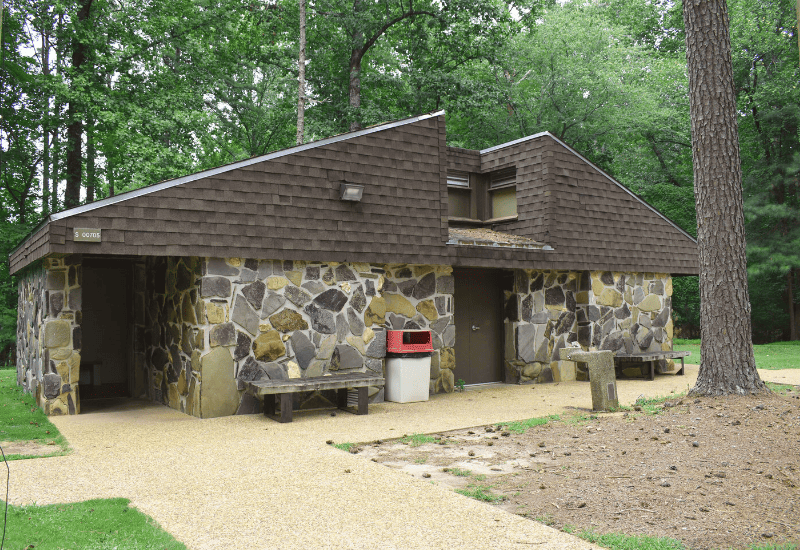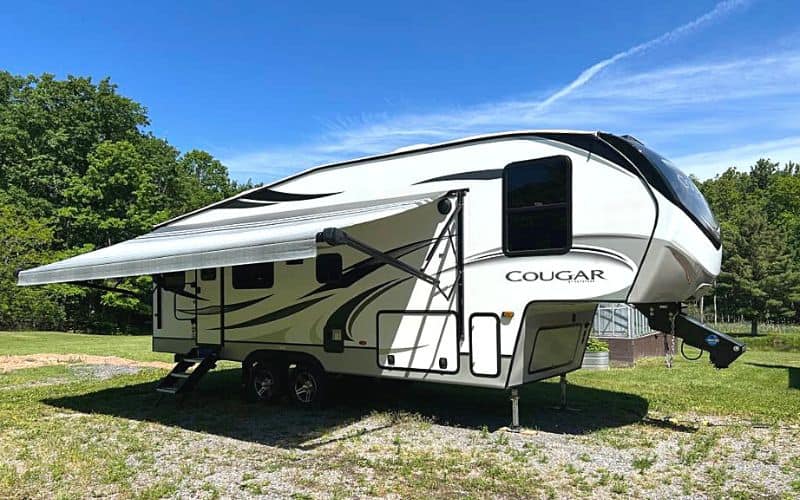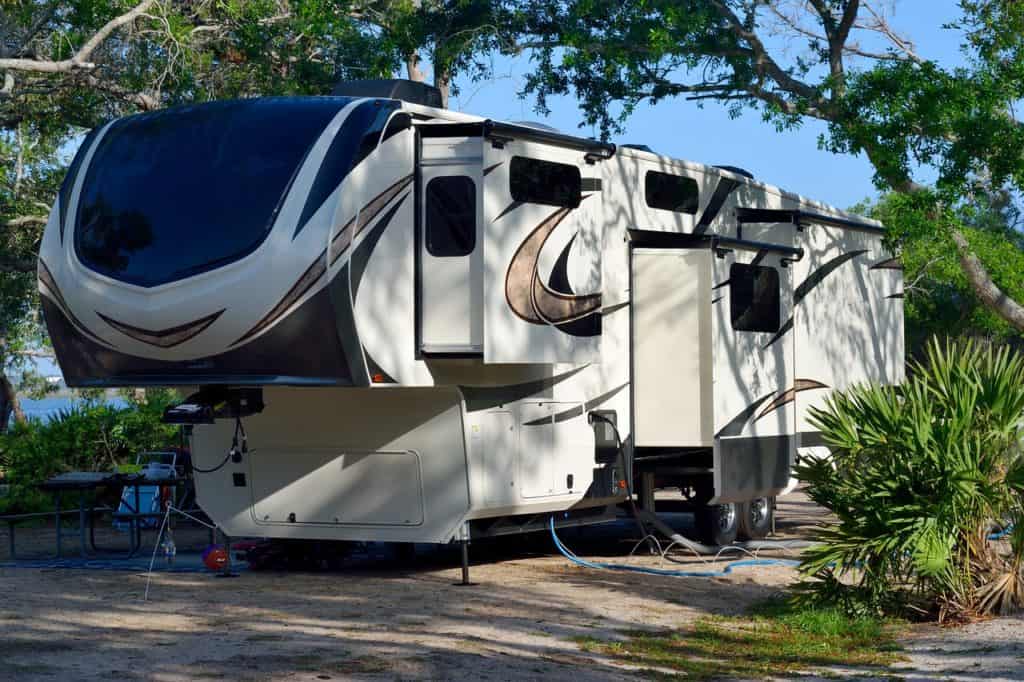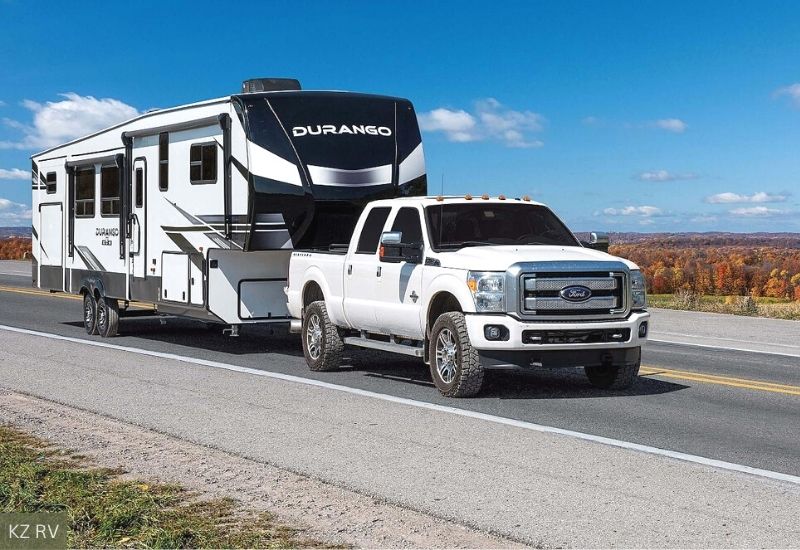While most of us check the weather forecast daily, weather, specifically wind plays a small role in our day-to-day lives.
However, when you’re RVing in a 5th wheel, weather — and wind, in particular — can have a significant impact, not only on your travel but also on your overall safety, as RVs are much more susceptible to weather and wind than permanent structures.
But how much wind is too much for an RV?
As an RVer, I’ve often wondered about this, especially when the camper starts to shake on a particularly windy day.
So I did a ton of research and even found a joint study done by Kent State University, Boyce Thompson Institute, and Wichita State University to answer the question, how much wind can a 5th wheel withstand?
Key Takeaways
- Most 5th wheels can withstand wind speeds of up to 50 MPH.
- Wind speeds over 60 MPH have the potential to tip over a 5th wheel, and this likelihood increases significantly with speeds over 80 MPH.
- There are many things you can do to prepare for high winds to reduce the likelihood of wind damage or tip-overs.
How Much Wind Can a 5th Wheel Handle Before it Tips Over?
The amount of wind a 5th wheel can withstand before tipping over depends on several factors, including its length, weight, weight distribution, whether it’s parked or in motion, its orientation to the wind, and whether its stabilizer jacks are down.
However, in general, wind speeds of over 60 miles per hour, have the potential to tip over a 5th wheel, and wind speeds over 80 miles per hour, have a high likelihood of tipping it over.
As a reference point, according to the National Weather Service, a moderate F1 tornado has wind speeds of between 73 and 112 miles per hour.
Now, this does not mean that your 5th wheel is going to tip over if the wind outside hits 60 miles per hour, it just means that the potential is there and you should prepare accordingly.
Because there are many things you can do to reduce the likelihood of a tip-over and wind damage
10 Things You Can Do to Prepare for Windy Conditions in an RV
As an RV enthusiast, preparing for all types of weather is part of the adventure.
Whether that’s rainy days in the spring, blistering heat in the summer, or cooler temperatures in the fall.
Windy conditions, in particular, however, require special care, to protect yourself, your family, and your RV.
1. Know When to Leave
The most important thing to know when it comes to storms and wind is to know when it’s time to leave the RV and seek more permanent shelter.
RVers often underestimate storms and the wind, choosing to ride them out inside the RV, assuming that it will be safe.
However, it only takes one time when it’s not.
So don’t risk it, if severe thunderstorms or high winds are approaching, secure the RV to the best of your ability and seek more permanent shelter.
2. Know Where to Go

Knowing when to leave the RV in bad weather is half the equation, the other half is knowing where to go.
In general, any permanent structure is a good choice for riding out a storm.
Some of the most popular options include storm shelters, storm cellars, campground bathrooms, camp stores, campground laundry facilities, and visitor centers.
3. Point the RV Into the Wind
If high winds are approaching, one of the best things you can do to reduce the likelihood of a tip-over is to figure out the direction of the wind and point the RV directly into it.
This will prevent the wind from hitting the camper’s broadside, which will dramatically reduce the likelihood of the RV tipping over.
By positioning the RV nose or tail into the wind, you minimize the surface area exposed to the strongest wind forces.
In addition, this alignment helps distribute the wind’s pressure more evenly across the RV’s structure, further enhancing stability and reducing the risk of damage.
4. Deploy Stabilizer or Leveling Jacks
While RV stabilizers or leveling jacks won’t prevent an RV from tipping over, they do add another line of defense against the wind.
As they provide the RV with additional contact points with the ground, which helps to distribute the wind’s forces more evenly.
In addition, stabilizers or leveling jacks provide a firmer stance for the RV and reduce the likelihood of rocking or swaying due to wind gusts.
5. Hitch Your Tow Vehicle to the Trailer
Unless you’re using your tow vehicle to drive to a storm shelter or evacuate the area, hitching your tow vehicle to the trailer can provide additional stability to the camper.
This added weight and connection to the tow vehicle can help anchor the trailer, making it less susceptible to being pushed around by strong winds.
The combined mass of the tow vehicle and the camper also creates a more substantial base, which can be particularly beneficial in buffering against side winds.
6. Bring Your Awning In

You should bring in your awning even during light winds; however, it’s especially important to do so during storms and high winds.
So as soon as the wind starts to pick up, bring the awning in.
Better safe than sorry.
7. Bring Your Slides In
While you don’t need to bring your slides in during mild weather and light rain, if the forecast is calling for severe thunderstorms or high winds, it’s best to bring your slides in.
Bringing in your slide-outs under these conditions reduces the surface area exposed to harsh elements, lowering the risk of damage.
This precaution also helps in maintaining the structural integrity of your RV, as the slides can be vulnerable to strong wind forces and heavy rainfall, potentially leading to leaks or other issues.
8. Secure & Store All Outdoor Items
One of the biggest risks to your RV from high winds is impacts from objects hitting the RV.
So if storms or high winds are expected, make sure all loose and lightweight items are secured or brought inside the RV.
This includes items like patio furniture, grills, bikes, outdoor decorations, and potted plants.
By ensuring that these objects are safely stowed away, you minimize the risk of them becoming airborne projectiles and causing damage to your RV or surrounding areas during strong wind events.
9. Fill Your Water Tanks
The heavier your RV is the less likely it will be to tip over in high winds.
So if you have the time, one of the best ways you can add weight to your RV is to fill your RV’s water tanks.
As one gallon of water weighs approximately 8.34 pounds, this means that if your RV has a 40-gallon water tank you can add roughly 333 pounds of weight to your RV.
Which will not only reduce the likelihood of a tip over but will also make the RV more stable in high winds.
10. Don’t Park Near or Under Trees

While everyone loves a wooded campsite with lots of shade, nearby trees can be a major risk factor in storms, as they can often drop branches and can even fall in extreme winds.
As small branches can break off in winds as low as 39 miles per hour and trees can be uprooted in winds as low as 55 miles per hour.
So before storms and high winds hit the campground, if your RV is parked near or under trees, it’s best to move your rig to a safer location to reduce the likelihood of damage.
Best Ways to Monitor Weather and Wind Conditions While RVing
Now that you know what to do if storms or high winds are approaching your campsite, the next step is to stay informed about the weather.
Effective monitoring of weather and wind forecasts is essential for any RV trip, especially in areas prone to sudden weather changes and high winds.
These are the best ways I’ve found to monitor the weather and wind.
Hi-Tech Options
One of the best ways to monitor the weather and any potential storms or high winds approaching your campsite is your phone.
As there are many helpful apps these days that can provide real-time information on current and future weather.
You can even set alerts on these apps so that if bad weather is approaching you’ll be notified.
Below are some of my personal favorites:
- Weather Channel – Provides real-time weather forecasts, alerts, radar maps, and detailed meteorological information for locations worldwide.
- My Radar – Fast, user-friendly weather application that offers real-time radar images and weather alerts, helping users stay informed about current and upcoming weather conditions.
- Windy – Interactive tool offering detailed and visually engaging weather forecasting, specializing in wind, waves, and other meteorological data, ideal for outdoor enthusiasts.
Low-Tech Option
High-tech weather monitoring and smartphones are great, as they provide very detailed forecasts and up-to-the-minute information, however, they should never be relied on solely.
As they require an internet connection to work as well as power.
Which might not always be available, especially if you’re boondocking in remote locations.
Because of this, you should always have a low-tech backup, and the best option for this is a NOAA (National Oceanic and Atmospheric Administration) weather radio.
A NOAA weather radio is a dedicated radio receiver that provides continuous broadcasts of weather information directly from the nearest National Weather Service office.
Broadcasting official Weather Service warnings, watches, forecasts, and other hazard information 24 hours a day, 7 days a week.
And the best part is, they don’t need an internet connection to work.
There are many NOAA weather radios on the market and they all pretty much do the same thing.
However, I would recommend getting one equipped with a hand crack, as it will work even if its batteries are dead.
The one I like the most is the FosPower Emergency Weather Radio (Model A1), which you can see on Amazon by clicking here.
What to Do if You Encounter Windy Conditions While Towing a 5th Wheel

RVs and 5th wheels, which are high-profile vehicles are very susceptible to wind, especially when going down the road and at higher speeds.
As they act like big sails in the wind, which can upset the vehicle’s stability, cause them to be pushed around, and worst case scenario, cause them to tip over.
So what should you do if you encounter high winds while traveling in or towing an RV?
If you encounter winds over 30 miles per hour, and especially over 40 miles per hour, while traveling in or towing an RV, you should slow down, get off the road, and find a safe place to ride out the wind.
Because continuing to drive in such conditions not only puts you at risk but also other motorists.
High winds can make it difficult to control your RV, increasing the likelihood of accidents.
When finding a safe place to park, choose a spot that is shielded from the wind’s direction, if possible.
If not, make sure to point the RV into the wind and avoid parking under trees or near other large objects that could fall or cause damage to the camper.
Remember, safety should always be your top priority on the road, not sticking to a rigid travel timeline.
Don’t worry your destination isn’t going anywhere.
Recent Posts
When cruising down the highway in your RV, the last thing you want is a tire blowout! Not only is it dangerous, but RV tire replacement isn't cheap, costing $200 to $300 per tire. The good news,...
Nothing ruins an RV adventure faster than a breakdown with no way to fix it. Because of this, every RVer should have a well-stocked RV tool kit for those unexpected roadside emergencies and campsite...

